How and when to feed the apple tree?

Many gardeners give preference to growing apple trees. It is this fruitful miracle of nature that gives people an excellent harvest every year. However, to get juicy and tasty fruits, gardeners have to put in a lot of effort, since caring for apple trees involves special requirements.
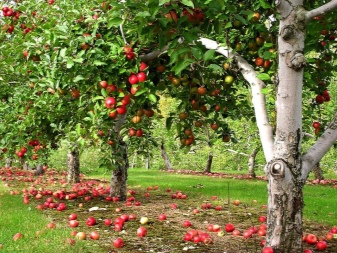

The needs of the apple tree for nutrients
Apple trees grow on almost every site of the summer cottage. They do not like transplants from place to place, respectively, the gardener must understand that on only a certain piece of land these fruit plantings will stretch upward. With proper care, each tree pleases its owner with a rich harvest for several decades. At the same time, the taste and richness of the fruit is determined by the taking of useful minerals from the soil.
Without fertilizers, after a while, the soil composition is depleted. The tree has nowhere to take natural fertilizing, which means that the yield of the fruit crop is decreasing. The tree itself begins to ache and may die. To prevent this from happening, it is necessary to make timely fertilization of the apple tree. Top dressing should be started with the appearance of the first leaves on the branches. The development of foliage is influenced by nitrogen fertilizers or complex mixtures, which contain potassium, nitrogen and phosphorus. In this case, nitrogen and phosphorus will begin to work immediately, and potassium is activated several days before flowering.
Yablona tastes different types of fertilizers, both organic and mineral. The main thing is to strictly observe the proportions indicated in the instructions for use. For example, if there is more nitrogen than it should be, the apple tree will develop foliage, but no fruit. The tree will direct all its energy due to an excess of nitrogen to the development of shoots.
The worst thing is that an overdose of mineral fertilizers can damage the root system of a tree, and it can die.
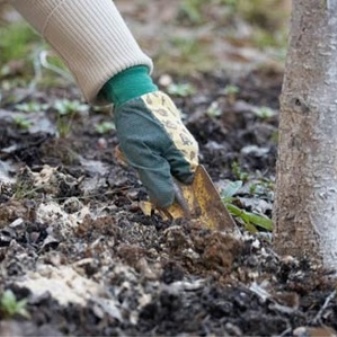

Possible fertilizers
Few people know that shepherds were the first to find out that fertilizers are good for plants. As they guided livestock from pasture to pasture, they noticed that the land, enriched with dung from walking animals, was growing lush vegetation. After that, villagers near rivers found that feeding apple trees with fish and algae increased their productivity and were less prone to iron deficiency.
Thus, the list of organic fertilizers increased. After some time, with the development of science and new technologies, the chemical industry has managed to develop a wide range of dressings obtained from the mineral base. And now the gardener can only choose the most acceptable option.
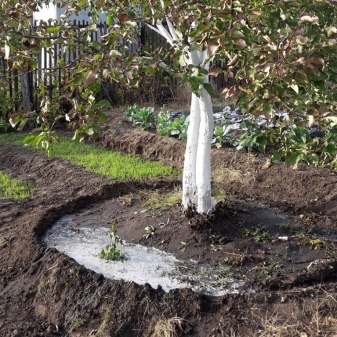
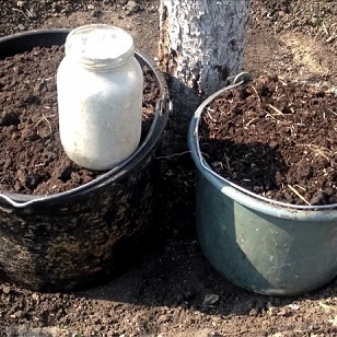
Organic
Gardeners who choose organic feeding need to stock up on liquid manure or make compost. It is allowed to use rotted manure. This top dressing should be scattered in the trunk circles, in a ratio of 4-5 buckets per adult apple tree. But it is much more convenient if the fertilizer has a liquid consistency. It is much easier for a gardener to feed a fruit tree, and it is easier for the tree itself to assimilate the introduced organic matter.
Manure contains a huge amount of potassium, which is well retained in the soil. The rain has no effect on potassium, which is why it is enough to make 1 feeding of the apple tree root system in July.It is worth noting, despite the multiple positive qualities of manure, it has a drawback, namely, the absence of phosphorus in the composition. Accordingly, the gardener will have to add additional phosphorus supplements. Fish or bone meal is ideal.
The amount of dressings is calculated based on the soil composition of the site. For example, black soil is rich in nitrogen. If the apple tree grows on black soil, nitrogen fertilization should be done only once in the spring. If the soil is sandy, top dressing will have to be introduced several times during the growing season. Further, it is proposed to deal with bone meal in more detail. It contains not only phosphorus. Calcium and potassium are also present there. The amount of nitrogen is no more than 3%. Calcium affects the palatability of apples, since it is this element that takes part in the formation of sweetness.
Bone meal is a long-lasting fertilizer. The time for its complete dissolution is 8 months. But this does not mean that feeding will be carried out only after the specified period. The flour will begin to dissolve after being added to the soil. It gradually releases the necessary substances for plants, respectively, the feeding of fruit trees will take place on an ongoing basis.


Bone meal is applied under apple trees in the autumn, when fruiting ends. During the winter months, it is processed into essential substances that nourish and support trees. Next, you should carefully read the fish meal. It contains organic phosphorus and 10% nitrogen. There is much more phosphorus and potassium than bone meal. When applying fishmeal, the soil is alkalized. That is why it is often used on acidified soil. By the way, it is fishmeal that is an excellent medicine for restoring the root system of trees.
Another fairly popular organic fertilizer is wood ash. It is the remains of burnt plants such as straw or wood. It contains many nutrients that can be fed to apple trees during ripening and fruiting. It is imperative for Apple to constantly get large amounts of potassium. This feeding element is very quickly drawn out of the manure fertilizer, therefore, wood ash should be added as additional care. But do not sprinkle it on top, but dig it up with the ground adjacent to the trunk.
It should be noted that the trace elements present in wood ash help plants to cope with diseases, improve their metabolism. In addition to nutrition, wood ash is responsible for the supply of oxygen to the soil. And this is extremely important for young apple trees. Their root system is still fragile, weak, just beginning to develop, and the presence of oxygen for this process is extremely necessary.
Gardeners should remember that if their apple orchard grows on clay soils, wood ash will be the most essential fertilizer that can loosen the soil and facilitate the tree's growth process.
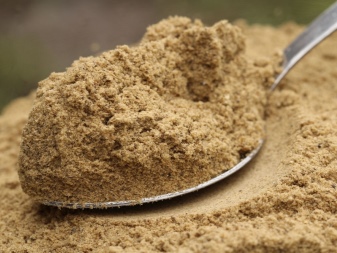
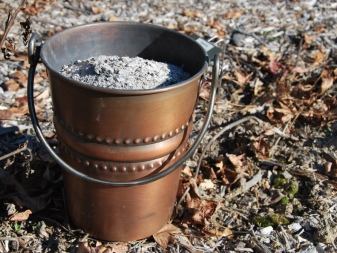
Mineral
Before dealing with the features of mineral fertilizers, you should get acquainted with their general concept. First of all, you need to remember that this is an inorganic compound, which contains the nutrients required for plants in the form of mineral salts.
The most suitable mineral fertilizer for apple is urea. In scientific terminology, it is called "urea". It contains a large amount of nitrogen, therefore, when diluting it, it is important to follow the proportions indicated in the instructions. The composition of mineral fertilizers contains a large amount of nitrogen and important trace elements. Everyone knows that a lack of trace elements causes chlorosis in an apple tree - the death of foliage and shoots. If suddenly the gardener noticed that spots appeared on the leaves or their tips began to dry, then it is necessary to process with a solution.On sale you can find both specialized and universal formulations.
Processing must be done in the evening, preferably in cloudy weather. Thus, the foliage will be saturated with the solution and will take in the necessary components of the feeding.
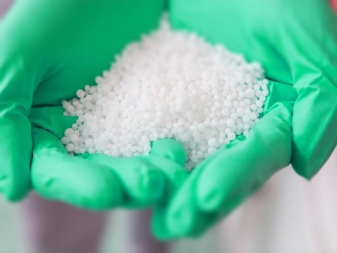
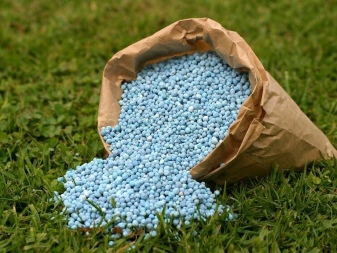
Terms and rules for applying top dressing
The ideal date for the introduction of fertilizers is considered to be the end of agrotechnical work. In simple words, after cutting the crown, whitewashing the trunk and carrying out winter watering. For the complete assimilation of the introduced fertilizer, the apple tree needs at least 3 weeks. Throughout this time, it is necessary to moisten the soil composition next to the trunk. However, if regular rain falls on the street, this event can be ignored.
According to the rules of horticulture, feeding depends entirely on the age of the fruit tree. The concentration of the created fertilizer also depends on this indicator. For example, young seedlings are preferably fertilized in the autumn. It is desirable that the fertilizer contains phosphorus and potassium. The solution is made as follows: 4 tbsp is mixed. l. phosphorus-potassium fertilizer with 10 liters of water. The water should be slightly heated, otherwise the fertilizer will not dissolve. Wood ash can be used as additional feeding. Amateur gardeners who grow apple trees on their plot do not fully understand the difference between caring for a seedling and an adult tree. An important difference is that young trees that do not have strong immunity and do not bear fruit need a different concentration of dressings. They also require other substances.
It is strictly forbidden to feed young seedlings with dry mixtures, since the latter can burn the root system. But the diluted solution should be used with extreme caution. However, many gardeners, who repeatedly use different dressings, advise, when breeding a composition for young trees, to divide the cooking formula by 2. In simple words, if the recipe indicates to use 2 tbsp. l. substances to be dissolved 1.
Young apple trees tolerate mineral feeding well, but it is much better to use organic fertilizers for them. For example, wood ash. With its help, a young plant will be able to survive even a harsh winter, while the internal process of tree development will proceed as expected. By the way, some gardeners use holes for feeding young seedlings. But this cannot be done, this method can damage the root system of plants.
If you do not adhere to the presented feeding rules, it is highly likely that the soil will be oversaturated with useful trace elements. Accordingly, trees will begin to age very quickly, and this will negatively affect their life expectancy and productivity.
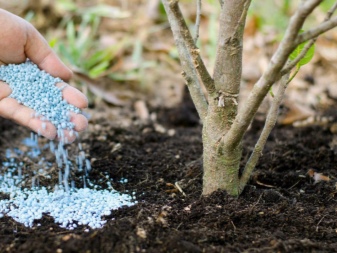
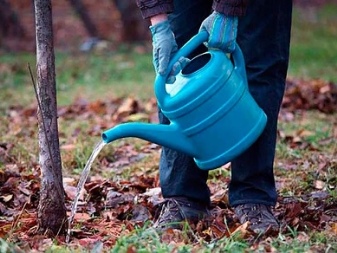
When landing
Inexperienced gardeners begin to feed young seedlings immediately after planting. However, this is not recommended. A young tree must take root in the new soil and begin to receive from it the elements required for growth. This means that the necessary fertilizers should be introduced into the planting pit.
Ideally, dig a hole with dimensions 50x50 cm, where the 1st number means the diameter, and the 2nd number means the depth. At the bottom of the pit, 200 g of wood ash should be poured. As an analogue, you can use 10 g of potash fertilizers. Next comes black soil mixed with superphosphate. About 15 cm of the hole remains empty, where the main food is laid - soil mixed with humus in the same ratio.
Complex fertilizer, diluted according to the attached instructions, is introduced as a supplement for autumn planting. If the seedlings are planted in late autumn, the feeding will not have time to be fully absorbed. Large amounts of nitrogen will damage the root system of the tree. It is better to produce complex nutrition for the apple tree in the spring. For wintering, what was laid in the planting hole is enough.
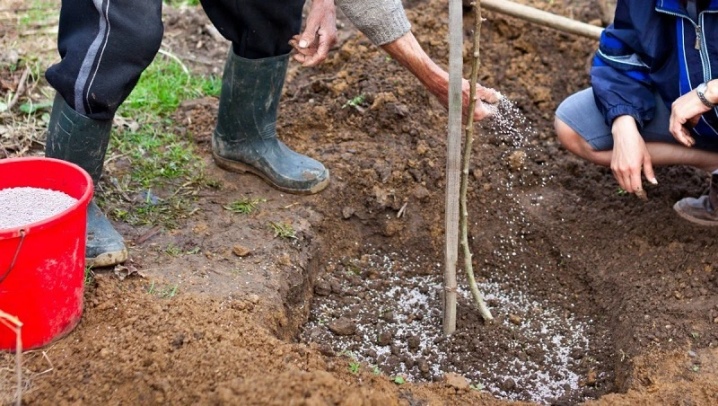
In the spring
For plants, winter is a time of calm after flowering and harvesting. During this period, the kidneys prepare for the growing season. However, they do not need food. As long as the air temperature is low, the plants absorb essential nutrients from the soil.
Sap flow begins in March. Accordingly, it is necessary to begin to introduce fertilizers. Thus, it will be possible to guarantee good growth and yield of the apple tree. In April, when the spring air temperature overcomes cold fronts, leaves and flowers appear on the buds. The root system is activated, and it begins to absorb nutrients. When the apple tree is rapidly assimilating nutrients by the roots, and photosynthesis begins in the leaves, it is extremely difficult for the tree to keep the necessary needs in balance. Accordingly, the apple tree begins to pick up substances that have been preserved in the roots, stem and branches from the past vegetation.
At this stage of development, a fruiting tree requires nitrogen, phosphorus and potassium. Boron and zinc should be considered as additional feeding. The last 2 elements are present in the compositions of organic fertilizers, which means that there is no need to add them additionally.
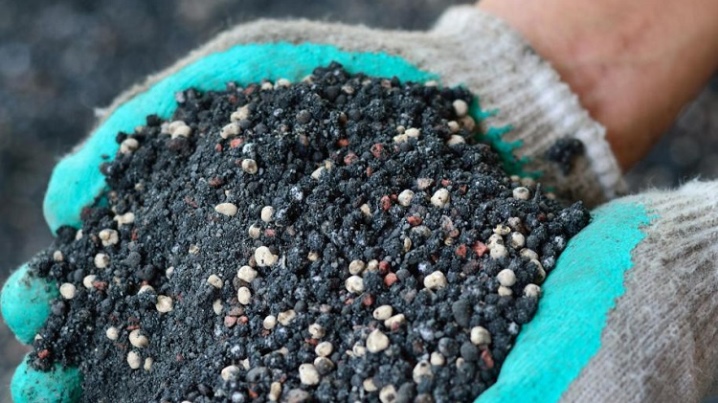
Summer
After the apple trees have bloomed, the energy of the tree is completely directed towards growing fruits and laying future buds. The growing season generally ends in June when the buds are fully developed. At this stage of development, apple trees require a high amount of nutrients and sufficient moisture. They need nitrogen, phosphorus, potassium and calcium.
During fruiting, from July to September, apples show active growth and increase in weight. The emerging shoots stop stretching and begin to accumulate useful substances. During this period of development, the amount of nitrogen must be reduced, since it will negatively affect the quality of the fruit. But at the same time, the need for potassium increases in the tree.
With its help, the size of apples becomes larger, their taste characteristics are improved.
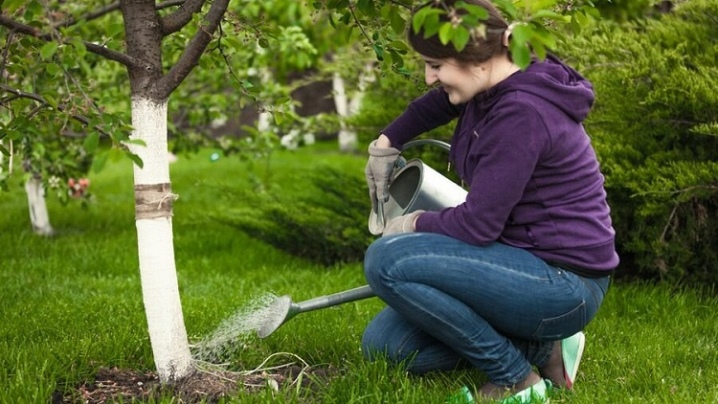
In autumn
In September, most of the nutrients collected by the leaves go to the stem and root of the apple tree. They are deposited as carbohydrates and amino acids, which the tree will need when spring comes.
As an autumn feeding, nitrogen should be used, introducing it by the foliar method. Thus, the supply of nutrients will increase. The most important thing is not to delay the feeding. Autumn fertilizers should be in warm soil. That is why in Siberia and the Urals, they begin to fertilize apple trees at the end of August. And in the southern parts of Russia, you can postpone autumn feeding until November.
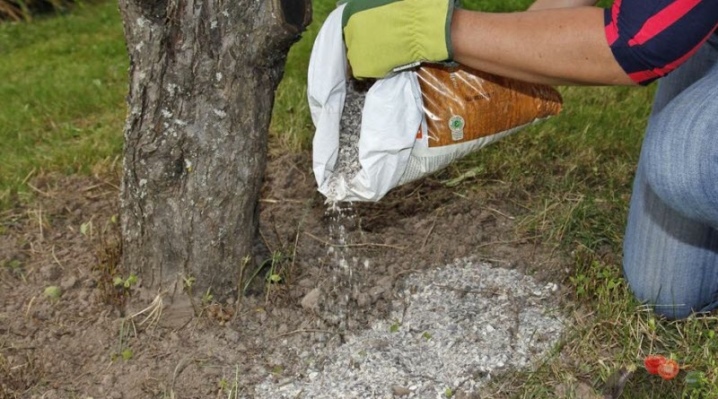
Frequent mistakes
When feeding apple trees, some gardeners make very gross mistakes.
- They do not adhere to the fertilizer introduction rates. It is very important to follow the instructions provided by the feed manufacturer. Lack and overabundance of nutrients negatively affects the vitality of the tree and yield.
- When using the root feeding method, some gardeners use more nitrogenous components. An overabundance of them negatively affects the condition of the tree. First of all, the crown is burned.
- A big mistake when foliar feeding is to carry it out at lunchtime. This method is preferably carried out in the morning or in the evening in cloudy weather.
- Some gardeners add more potassium to their fertilizers. But it is this element that becomes an obstacle to the active work of magnesium and phosphorus.
In fact, caring for fruit trees is not difficult. The main thing is to fertilize them on time with high-quality fertilizing, observe the proportions of the components and walk around the garden once a day, telling the trees how good they are. A kind word is pleasing to any creature.
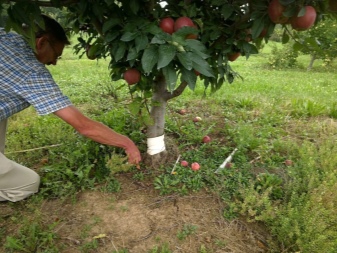

Experienced gardening tips
An important tip for experienced gardeners is to keep track of the amount of fertilizer applied. An overabundance or lack of fertilizing negatively affects the condition of the tree and the future harvest. For the introduction of fertilizers, it is important to consider the boundaries of the crown. The root processes of young apple trees do not stretch further than the branches. In mature trees, the root system can be one and a half times larger than the diameter of the crown itself. It is necessary to inspect trees annually, measure the growth of fruits, and control the biochemical composition of the soil.
For those who grow columnar apple trees using containers, it is necessary to remember that trees are not able to find fertilizers on their own, which is why they need to be fed every 2 weeks using balanced feeding.
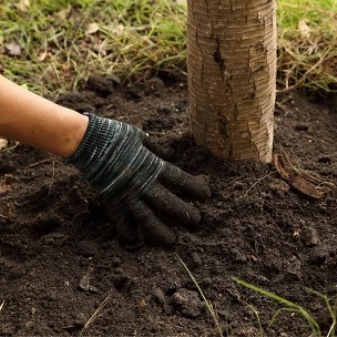

In the next video, you will find an express method for feeding an apple tree.













The comment was sent successfully.